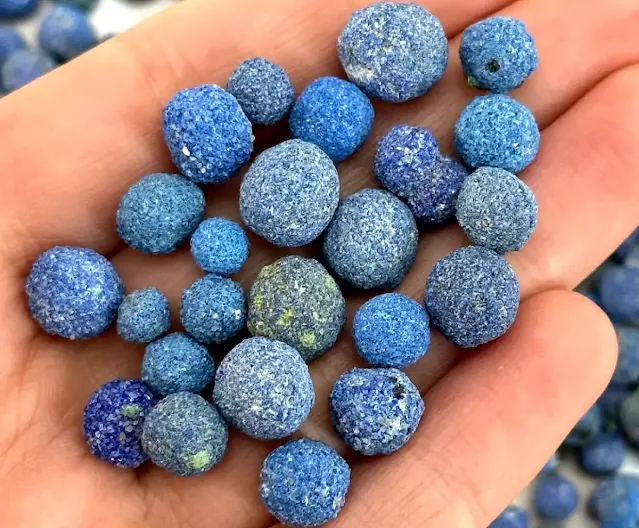What Are Azurite Geodes
Azurite geode is a geological formation where azurite crystals have grown within a cavity or void in a host rock, creating a stunning display of deep blue crystals. Azurite is a copper carbonate mineral known for its vibrant blue color.
These geodes are formed when copper-rich hydrothermal fluids dissolve rocks, leaving cavities. Over time, mineral-rich solutions fill these cavities, depositing crystals like azurite. The resulting geode can be a beautiful combination of the hollow rock exterior and the sparkling blue crystals within.
Azurite geodes come in a variety of shapes and sizes. Azurite geodes typically have a rough, unassuming outer surface, but when cracked open or cut, they reveal a dazzling interior filled with sparkling azurite crystals. The crystals may vary in size and shape, ranging from small, needle-like structures to larger, well-formed prisms.
Azurite geodes are not as common as some other types of geodes, but they are not incredibly rare either. The rarity of a specific azurite geode will depend on its size, quality, and the location where it was found.
Azurite Geodes Characteristics
Color: The most striking property of azurite geodes is their deep blue color, which comes from the azurite crystals lining the geode. The blue color can range from a light sky blue to a deep, almost indigo blue.
Crystal Structure: Azurite crystals are typically prismatic or acicular, meaning they are long and slender. They can also be druzy, massive or granular.
Hardness: Azurite is a relatively soft mineral, with a Mohs hardness of 3.5 to 4. This means that it can be scratched by a knife or other hard object.
Care: Due to their softness, azurite geodes require careful handling to prevent damage to the delicate crystals. Additionally, azurite is sensitive to light and moisture. To preserve their beauty, it's best to store them in a cool, dark place.
Metaphysical Properties: Beyond their captivating physical characteristics, azurite geodes are believed to possess metaphysical properties. Some people associate azurite with improved communication, creativity, and intuition. It's also considered a powerful stone for healing and protection.
 |
Azurite Geodes |
Where are azurite geodes found?
Azurite geodes are found in a variety of locations around the world, including:
- Russia: The Mikheevskoe Cu deposit in Russia produces azurite geodes. These geodes might have unique characteristics, like a vibrant blue color and possibly a hemispherical shape.
- Morocco: Morocco is a major source of azurite geodes, particularly the mines near Touissit. These geodes are known for their large size and beautiful deep blue azurite crystals.
- Mexico: Mexico is another significant source, with the Milpillas mine in Zacatecas being famous for high-quality specimens with well-formed crystals.
- United States: The United States has a few locations for azurite geodes, including Arizona and Utah. Specimens from these areas tend to be smaller than those found elsewhere.
- France: The Chessy copper mine in France was historically a major source, but it's now closed. Specimens from this location are considered quite rare.
 |
| Rough Azurite geodes |
 |
| Open Azurite Geodes, from Russia |
Azurite geodes are a remarkable fusion of geological wonder and captivating beauty. Their rarity, the mesmerizing blue color of the azurite crystals, and the potential metaphysical properties make them prized collectibles for geology enthusiasts and admirers of unique natural formations.



%20(1).webp)





